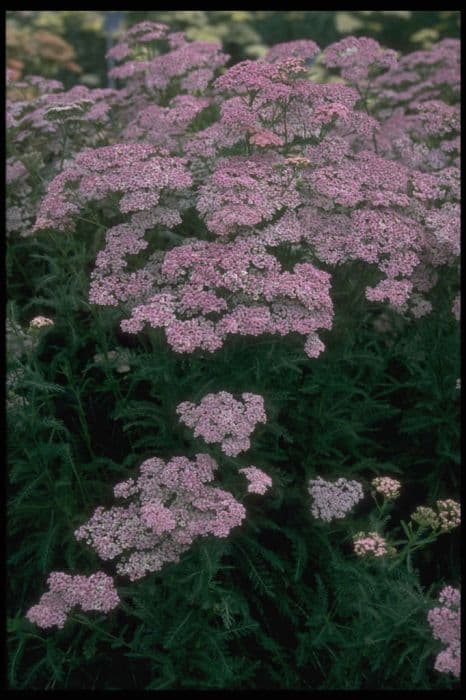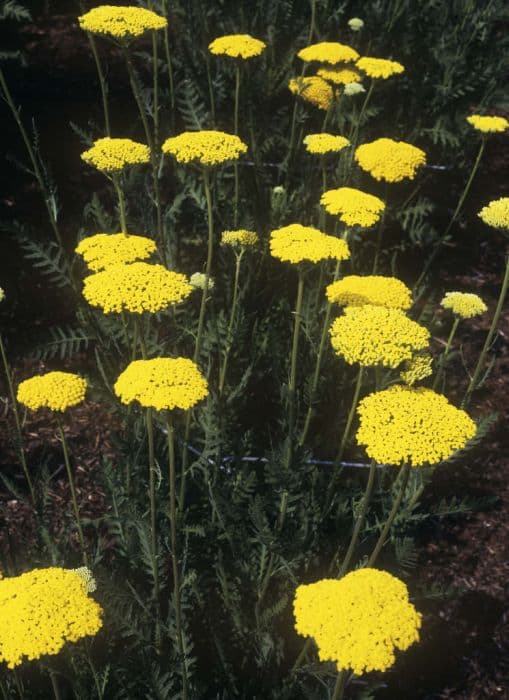Stokes Aster Stokesia laevis 'Blue Star'
ABOUT
Stokesia laevis 'Blue Star', typically referred to as the Stokes' aster, is a flowering perennial known for its distinctive floral display and attractive foliage. The hallmark of this plant is its blooms, which are large and showy with a mesmerizing shade of lavender-blue. These flowers have a frilly, fluffy appearance, resembling a pincushion surrounded by narrow, petal-like structures that create a starry effect. Typically blooming in the summertime, the Stokes' aster produces these star-like flowers atop slender, erect stems that gracefully rise above the foliage. The leaves of the Stokes' aster are deep green, forming a basal rosette at the ground level. These leaves are lance-shaped with slightly toothed margins and a somewhat rough texture. The overall impression of the Stokes' aster is one of an ornamental plant that brings a profusion of color and a touch of wildflower charm to gardens and landscaping designs. Its visual appeal is anchored in the striking contrast between the vivid blue flowers and the dense, dark green foliage.
About this plant
 Names
NamesFamily
Asteraceae
Synonyms
Stoke's Aster, Blue Danube Stokesia, Blue Star
Common names
Stokesia laevis 'Blue Star'.
 Toxicity
ToxicityTo humans
The Stokes' aster is not known to be toxic to humans. In general, it is considered a safe plant when touched or ingested in small amounts. However, like with any plant material, individuals may have sensitivities that could cause mild irritation, so it is always best to handle unknown plants cautiously and avoid ingesting them unless they are known to be edible and safe for consumption.
To pets
The Stokes' aster is not listed as toxic to pets either. This means that it is generally considered safe for dogs and cats, and there are no common reports of poisoning from this plant. However, as with humans, pets can sometimes have individual allergies or sensitivities, and ingestion of plant material can sometimes result in gastrointestinal upset such as vomiting or diarrhea. It's always prudent to keep an eye on pets around plants and to discourage them from chewing on plants that aren't meant for consumption.
 Characteristics
CharacteristicsLife cycle
Perennials
Foliage type
Evergreen
Color of leaves
Green
Flower color
Blue
Height
1-2 feet (30-60 cm)
Spread
1-2 feet (30-60 cm)
Plant type
Herb
Hardiness zones
5-10
Native area
Southeastern United States
Benefits
 General Benefits
General Benefits- Low Maintenance: Stokesia laevis 'Blue Star', commonly known as Stokes' aster, requires minimal upkeep and thrives with basic care.
- Drought Tolerance: Once established, Stokes' aster is drought-tolerant, making it an excellent choice for xeriscaping and water-wise gardens.
- Attracts Pollinators: The vibrant flowers attract butterflies and bees, which help in pollinating surrounding plants.
- Long Blooming Period: Stokes' aster has a long flowering season, often from early summer to early fall, providing extended visual interest.
- Deer Resistance: The plant is not a preferred choice for deer, reducing the likelihood of damage in areas with deer populations.
- Versatility: It can be used in various landscape applications, including borders, container gardens, and as a cut flower in bouquets.
- Color Addition: The striking blue flowers add a splash of color to gardens and landscapes.
- Compact Growth Habit: With its clumping form, Stokes' aster fits well in smaller gardens without taking too much space.
- Winter Hardiness: Stokes' aster is hardy in many climates and can survive through cold winters in its appropriate USDA hardiness zones.
- Easy Propagation: The plant can be easily propagated through division, allowing gardeners to create more plants for other areas of their garden or to share with others.
 Medical Properties
Medical PropertiesThis plant is not used for medical purposes.
 Air-purifying Qualities
Air-purifying QualitiesThis plant is not specifically known for air purifying qualities.
 Other Uses
Other Uses- Photography: Blue Star adds striking color and texture to a garden setting, making it a popular choice for photographers looking to capture the beauty of a garden landscape.
- Butterfly Gardens: The plant is known to attract butterflies, making it ideal for those wishing to create a butterfly haven in their garden.
- Educational Tool: Horticulture teachers might use Blue Star to demonstrate plant growth patterns, flowering stages, and pollinator interactions to students.
- Floristry: Blue Star's vibrant flowers can be used in cut floral arrangements to provide a pop of color and visual interest.
- Dye Production: Though not commonly used for dye, Blue Star could potentially be explored for natural dye extraction due to its pigmented petals.
- Art Inspiration: Artists may draw inspiration from the striking blooms of Blue Star, using its form and color as a basis for paintings, illustrations, and textile designs.
- Theme Gardens: It can be included in "star-themed" gardens due to its bloom shape and name, alongside other star-shaped flowers.
- Crafts: Dried Blue Star flowers can be used in craft projects, such as making bookmarks, potpourri, or decorative wreaths.
- Ecological Studies: Ecologists may plant Blue Star as part of a study to measure the health of a habitat based on the diversity and number of pollinators it attracts.
- Culinary Garnish: While not a traditional edible flower, Blue Star can be used as an ornamental garnish for its aesthetic value, but not consumed.
Interesting Facts
 Feng Shui
Feng ShuiThe Stokes' Aster is not used in Feng Shui practice.
 Zodiac Sign Compitability
Zodiac Sign CompitabilityThe Stokes' Aster is not used in astrology practice.
 Plant Symbolism
Plant Symbolism- Charm and Attraction: The 'Blue Star' stokes aster, with its luminous blue petals, is often associated with an irresistible charm that can attract positive attention and admiration.
- Endurance: As a hardy perennial that returns year after year, it symbolizes the trait of endurance and the ability to withstand challenges over time.
- Remembrance: Flowers often represent memories, and the stokes aster can signify an enduring remembrance of loved ones or cherished moments.
- Peace: Blue flowers are frequently linked to calmness and peace, and the 'Blue Star' stokes aster's gentle hue may embody tranquility in the garden or life.
 Water
WaterStokes' Aster requires regular watering to thrive, especially during its active growing season in spring and summer. Aim to water the Blue Star whenever the top inch of soil feels dry to the touch, which typically amounts to approximately once a week. Use around 1 gallon of water for each plant per watering session, ensuring that the moisture penetrates deeply into the soil to encourage strong root growth. During the fall and winter months, reduce watering to every other week, as the plant enters a dormant state and needs less water. Be cautious not to over-water, as Stokes' Aster does not like to sit in wet soil, which can lead to root rot.
 Light
LightStokes' Aster flourishes best in full sun conditions, meaning it should receive at least 6 to 8 hours of direct sunlight each day. The Blue Star should be planted in a spot where it is exposed to unfiltered sunlight for the majority of the day. However, in climates with very hot summers, the plant appreciates some afternoon shade to prevent scorching.
 Temperature
TemperatureStokes' Aster can tolerate a wide range of temperatures but grows best in climates with warm days and cooler nights. The Blue Star can survive minimum temperatures down to about 20 degrees Fahrenheit but is ideally kept in conditions where the temperature ranges between 60 and 80 degrees Fahrenheit. Extreme heat above 90 degrees Fahrenheit can be detrimental to the plant's health, so some shade during the hottest part of the day is beneficial.
 Pruning
PruningTo encourage vigorous growth and blooming in Stokes' Aster, prune or deadhead spent flowers regularly throughout the growing season. The best time for pruning the Blue Star is in late winter or early spring before new growth begins. Cut back the plant by about one-third to stimulate bushy growth and prepare it for the blooming season. Additionally, pruning in this manner helps maintain the plant's shape and health.
 Cleaning
CleaningAs needed
 Soil
SoilStokes' Aster thrives best in moist, well-draining soil with a pH of 5.5 to 6.5. A mix of loamy garden soil, peat moss, and sand is ideal to ensure proper drainage and aeration. Amending with organic matter can further enrich the soil.
 Repotting
RepottingStokes' Aster, typically grown as a perennial, doesn't need frequent repotting. It can be divided every 2-3 years to manage its spread and rejuvenate its growth.
 Humidity & Misting
Humidity & MistingStokes' Aster prefers average humidity conditions and does not require any special humidity adjustments when grown outdoors in its natural environment.
 Suitable locations
Suitable locationsIndoor
Ensure bright light, well-draining soil, and room for growth.
Outdoor
Plant in sun, use well-draining soil, water regularly.
Hardiness zone
5-9 USDA
 Life cycle
Life cycleThe life of a Stokes' aster 'Blue Star' begins with seed germination, which typically occurs in spring when soil temperatures warm. Following germination, the seedling stage involves the development of the root system and the first true leaves. As the plant enters the vegetative stage, it grows in size and produces a rosette of lance-shaped leaves at the base. During the flowering stage, usually in late spring to summer, Stokes' aster produces its characteristic blue-violet flowers atop sturdy stems, attracting pollinators. After pollination, the plant enters the fruiting stage where it forms seed heads that eventually mature by late summer or fall. Finally, the plant goes into a period of dormancy during the winter, especially in colder climates, with the cycle ready to begin anew with the next growing season.
 Propogation
PropogationPropogation time
Spring to Summer
Stokesia laevis 'Blue Star', commonly known as the Blue Star Stokes Aster, is commonly propagated through division, a method that allows gardeners to split the root system to create new plants. The best time for division is typically in the early spring or fall when the plant is not in its active growth phase. To propagate by division, remove the plant from the ground, gently tease apart the clump to separate it into smaller sections, ensuring that each new section has a part of the root system attached. These sections can then be planted in well-drained soil, spaced about 12 to 18 inches apart (approximately 30 to 45 centimeters), and watered thoroughly to help establish the new plants. Division is an easy and fast way to produce new Blue Star Stokes Aster plants that will be genetically identical to the parent plant.









